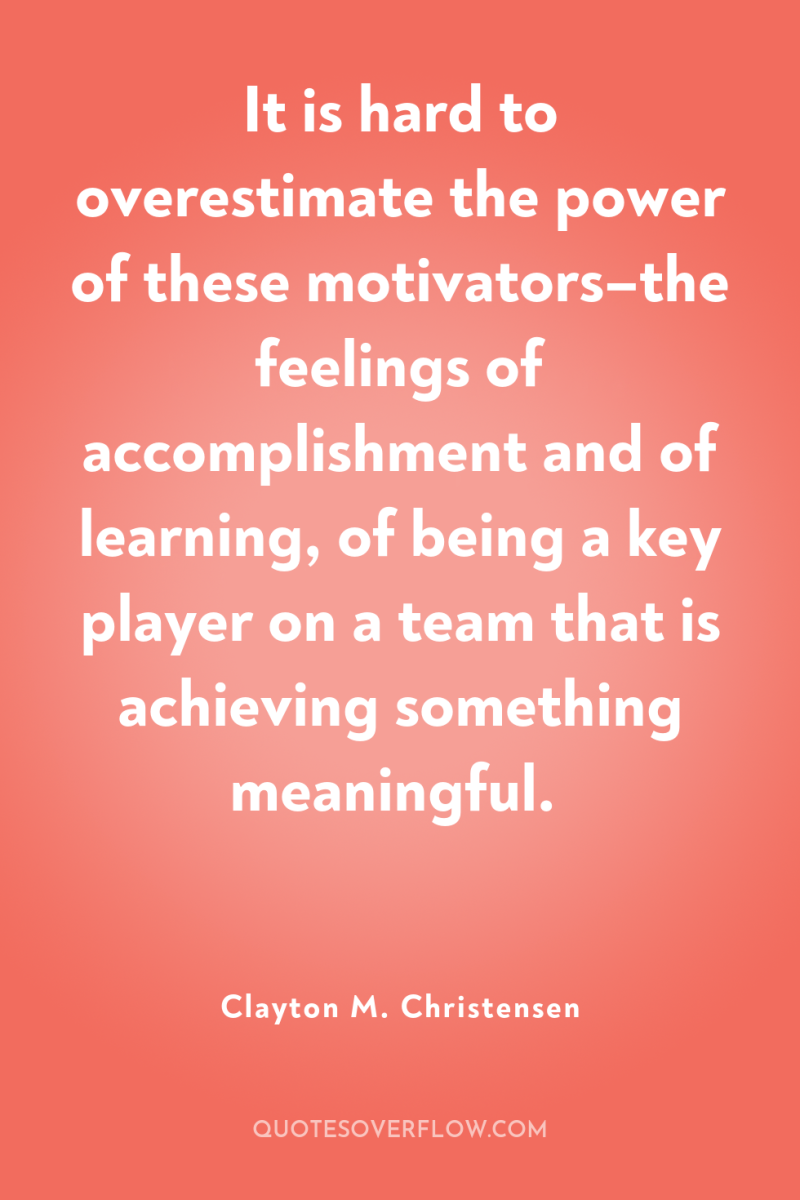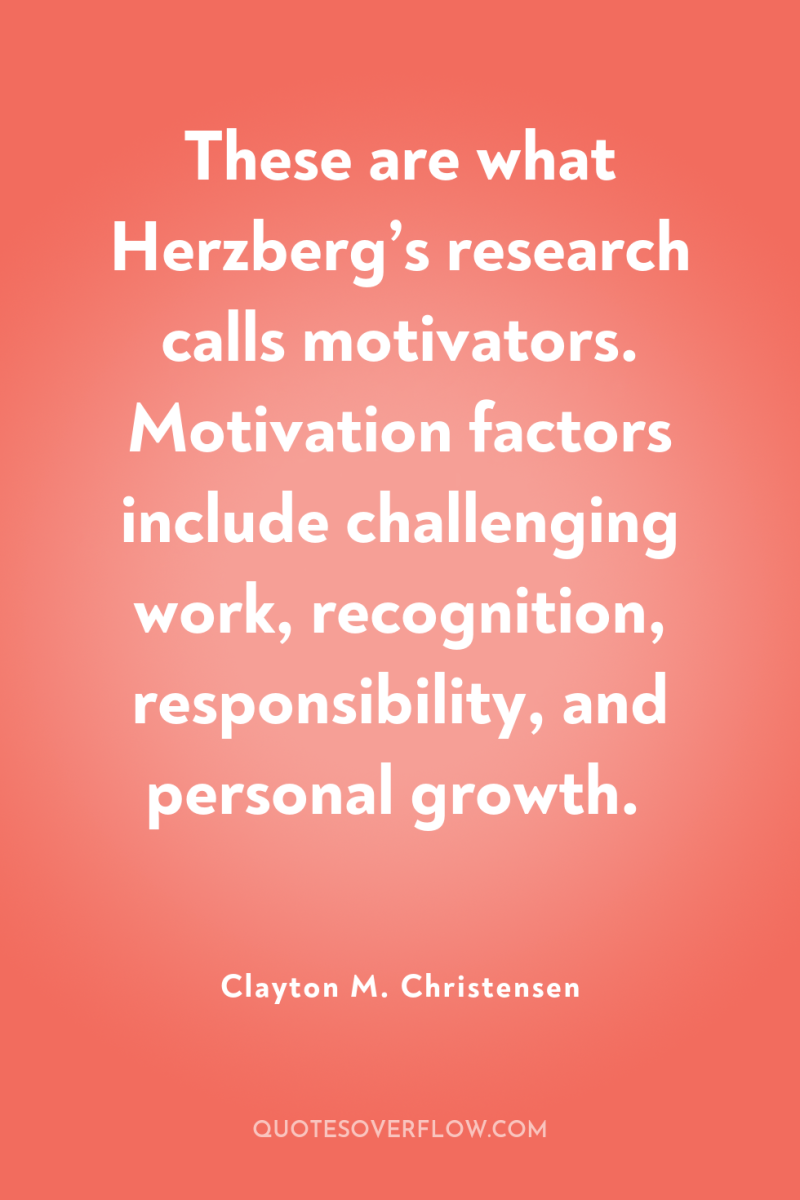1
We should always remember that beyond a certain point, hygiene factors such as money, status, compensation, and job security are much more a by-product of being happy with a job rather than the cause of it.Clayton M. Christensen

2
It is hard to overestimate the power of these motivators–the feelings of accomplishment and of learning, of being a key player on a team that is achieving something meaningful.Clayton M. Christensen

3
These are what Herzberg’s research calls motivators. Motivation factors include challenging work, recognition, responsibility, and personal growth.Clayton M. Christensen
4
Disruption is, at its core, a really powerful idea.Clayton M. Christensen
5
You can talk all you want about having a clear purpose and strategy for your life, but ultimately this means nothing if you are not investing the resources you have in a way that is consistent with your strategy. In the end, a strategy is nothing but good intentions unless it's effectively implemented.Clayton M. Christensen
6
If present rates of improvement continue, however, we would expect the cruising range of electric cars, for example, to intersect with the average range demanded in the mainstream market by 2015, and electric vechicle acceleration to intersect with mainstream demands by 2020.Clayton M. Christensen
7
To measure market needs, I would watch carefully what customers do, not simply listen to what they say. Watching how customers actually use a product provides much more reliable information than can be gleaned from a verbal interview or a focus group. Thus, observations indicate that auto users today require a minimum cruising range (that is, the distance that can be driven without refueling) of about 125 to 150 miles; most electric vehicles only offer a minimum cruising range of 50 to 80 miles. Similarly, drivers seem to require cars that accelerate from 0 to 60 miles per hour in less than 10 seconds (necessary primarily to merge safely into highspeed traffic from freeway entrance ramps); most electric vehicles take nearly 20 seconds to get there. And, finally, buyers in the mainstream market demand a wide array of options, but it would be impossible for electric vehicle manufacturers to offer a similar variety within the small initial unit volumes that will characterize that business. According to almost any definition of functionality used for the vertical axis of our proposed chart, the electric vehicle will be deficient compared to a gasolinepowered car. This information is not sufficient to characterize electric vehicles as disruptive, however. They will only be disruptive if we find that they are also on a trajectory of improvement that might someday make them competitive in parts of the mainstream market. The trajectories of performance improvement demanded in the market–whether measured in terms of required acceleration, cruising range, or top cruising speed–are relatively flat. This is because traffic laws impose a limit on the usefulness of ever-more-powerful cars, and demographic, economic, and geographic considerations limit the increase in commuting miles for the average driver to less than 1 percent per year. At the same time, the performance of electric vehicles is improving at a faster rate–between 2 and 4 percent per year–suggesting that sustaining technological advances might indeed carry electric vehicles from their position today, where they cannot compete in mainstream markets, to a position in the future where they might.Clayton M. Christensen
8
When I have my interview with my God, our conversation will focus on the individuals whose self-esteem I was able to strengthen, whose faith I was able to reinforce, and whose discomfort I was able to assuage–a doer of good, regardless of what assignment I had. These are the metrics of that matter in measuring my life. This realization, which occurred nearly fifteen years ago, guided me every day to seek opportunities to help people in ways tailored to their individual circumstances. My happiness and my sense of worth has been immeasurably improved as a result. .Clayton M. Christensen
9
One quarter of Medicare beneficiaries have five or more chronic conditions, sees an average of 13 physicians each year, and fills 50 prescriptions per year.Clayton M. Christensen
10
…I came to understand that while many of us might default to measuring our lives by summary statistics, such as number of people presided over, number of awards, or dollars accumulated in a bank, and so on, the only metrics that will truly matter to my life are the individuals whom I have been able to help, one by one, to become better people.Clayton M. Christensen
11
No idea for a new growth business ever comes fully shaped. When it emerges, it's half-baked, and it then goes through a process of becoming fully shaped.Clayton M. Christensen
12
A disruptive innovation is a technologically simple innovation in the form of a product, service, or business model that takes root in a tier of the market that is unattractive to the established leaders in an industry.Clayton M. Christensen
13
The breakthrough innovations come when the tension is greatest and the resources are most limited. That's when people are actually a lot more open to rethinking the fundamental way they do business.Clayton M. Christensen
14
The dumb-manager theory of business problems just didn't hold water for me. There had to be a deeper reason why smart people would make decisions that lead to failure.Clayton M. Christensen
15
The single most important factor in our long-term happiness is the relationships we have with our family and close friends.Clayton M. Christensen
16
As a general rule, when a new industry takes root, and the first products emerge in a wave, almost always the architecture of the product will be proprietary and interdependent in character.Clayton M. Christensen
17
In the universities, we teach you what we decide you need to know. And the employers find out when they hire people that students didn't learn what we needed them to learn. Online learning offerings, like the University of Phoenix, have relationships with employers and teach what you need to know.Clayton M. Christensen
18
What's unique about the Mormon Church is that it encourages inquiry. I really do think my research and religion are all on the same page. I never could have come up with the notion of disruptive innovations, which went against a lot of conventional wisdom, if I hadn't been raised to always be asking questions.Clayton M. Christensen
19
Things happen to us in unpredictable ways, but the effect that that has on the kind of people who we become actually is not only open to chance - we can influence it in pretty profound ways.Clayton M. Christensen
20
American capitalists, enthralled by the doctrines of finance, have put their income statements in service of the balance sheet.Clayton M. Christensen
21
For 300 years, higher education was not disruptable because there was no technological core.Clayton M. Christensen